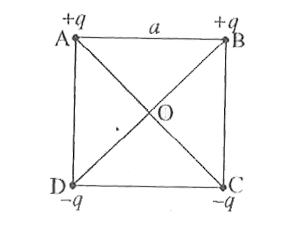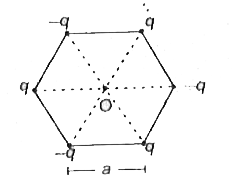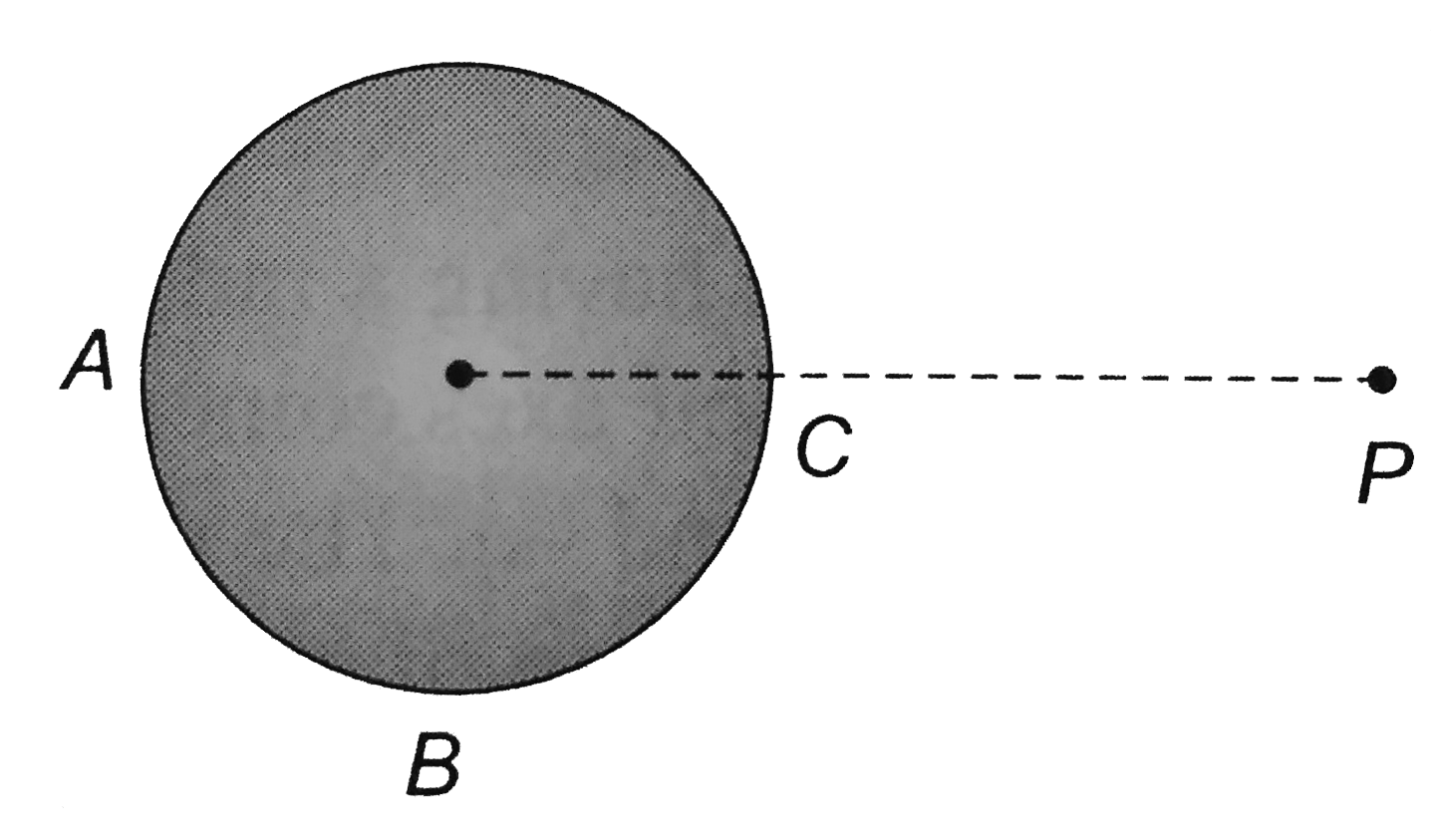Charges are placed on the verticles of a as shown. Let →E be the electric field and V the potential at the centre. If the charges on a and B are inercharged with those on D and C respectively, then-
 Solution in Gujrati
Solution in Gujrati
→E remains unchanged, V changes
both →E and V change
→E and V remain unchanged
→E charges and V remains unchanged
The correct Answer is:D
Potential remains same as it depends on algebraic sum of charges but electric field →E charges.
Topper's Solved these Questions
- MISCELLANEOUSBOOK - ALLEN CHAPTER - MISCELLANEOUSEXERCISE - Exercise-05(B)
19 Videos
- MISCELLANEOUSBOOK - ALLEN CHAPTER - MISCELLANEOUSEXERCISE - MCQ s WITH ONE OR MORE THAN ONE CORRECT ANSWER
6 Videos
- MISCELLANEOUSBOOK - ALLEN CHAPTER - MISCELLANEOUSEXERCISE - Exersice-04[B]
16 Videos
- KINEMATICS (MOTION ALONG A STRAIGHT LINE AND MOTION IN A PLANE)BOOK - ALLEN CHAPTER - KINEMATICS (MOTION ALONG A STRAIGHT LINE AND MOTION IN A PLANE)EXERCISE - BEGINNER S BOX-7
8 Videos
- PHYSICAL WORLD, UNITS AND DIMENSIONS & ERRORS IN MEASUREMENT BOOK - ALLEN CHAPTER - PHYSICAL WORLD, UNITS AND DIMENSIONS & ERRORS IN MEASUREMENT EXERCISE - EXERCISE-IV
7 Videos
Similar Questions
A charge +q is fixed at each of the points x=x0, x=3x0, x=5x0,…………x=∞ on the x axis, and a charge −q is fixed at each of the points x=2x0, x=4x0, x=6x0, …………x=∞. Here x0 is a positive constant. Take the electric potential at a point due to a charge Q at a distance r from it to be Q/(4πε0r).Then, the potential at the origin due to the above system of
View SolutionA positively charged thin metal ring of radius R is fixed in the xy plane with its centre at the origin O. A negatively charged particle P is released from rest at the point (0,0,z0) where z0>0. Then the motion of P is
View SolutionTwo small balls having the same mass and charge and located on the same vertical at heights h1 and h2 are thrown in the same direction along the horizontal at the same velocity v. The first ball touches the ground at a horizontal distance R from the initial vertical position. At what height h2 will the second ball be at this instant? Neglect any frictional resistance of air and the effect of any induced charge on the ground.
View SolutionA football player kicks a ball at an angle of 30∘ with an initial speed of 20 m/s. Assuming that the ball travels in a vertical plane, calculate (a) the time at which the ball reaches the highest point (b) the maximum height reached (c) the horizontal range of the ball (d) the time for which the ball is in the air, (g=10m/s2)
View SolutionAssertion : Gravitational forces do not depend on the medium between the masses.
Reason : Mediating particle responsible for gravitational force is graviton.
View SolutionCharges are placed on the vertices of a square as shown

Let →E be the electric field and V the potential at the centre. If the charges on A and B are interchanged with those on D and C respectively, then
View SolutionA charge +Q at A (see Fig. 3.140) produces electric field E and electric potential V at D. If we now put charges −3Q and +Q at B and C, respectively, then the electric field and potential at D will be
 .
.
View SolutionA hollow conducting sphere is placed in an electric field produced by a point charge placed at P as shown in figure. Let V_(A), V_(B), V_(C ) be the potentials at points A, B and C respectively. Then
View SolutionA charge +Q at A (see figure) produces electric field E and electric potential V at D . If we now put charges -2Q and +Q at B and C respectively, then the electric field and potential at D will be
View SolutionCharges are placed on the verticles of a as shown. Let vec(E) be the electric field and V the potential at the centre. If the charges on a and B are inercharged with those on D and C respectively, then-
View SolutionCharges are placed on the vertices of a square as shown. Let E r be the electric field and V the potential at the centre. If the charges on A and B are interchanged with those on D and C respectively, then :-
View Solutionएक वर्ग के कोनों पर आवेश चित्र की भाँति रखे हैं| माना इसके केंद्र पर विद्युत् क्षेत्र →E तथा विद्युत् विभव V है | यदि A तथा B पर रखे आवेश C तथा D पर रखे आवेशों से परस्पर प्रतिस्थापित कर दिए जाते हैं, तो-

View SolutionSix point charges are placed at the vertices of a regular hexagon of side a as shown. If E represents electric field and V represents electric potential at O then,

View Solution{:((i)"Quantisation of charges",(a) int_(infty)^(P)- vec(E).d vec(r) ),((ii)"Electric field",(b)"ne"),((iii)"Electric dipole moment",(c) (F)/(q)),("(iv) Electric potential",(d)2qa):}
View SolutionA charge + Q at A as shown in fig. produces electric field E and electric potential V at D. if we now put charges -2 Q and + Q at B and C respectively , then the electric field and potential at D will be :
View SolutionA hollow conducting sphere is placed in an electric field produced by a point charge placed at P as shown in figure.
Let VA,VB,VC be the potentials at points A,BandC respectively. Then

View Solution
